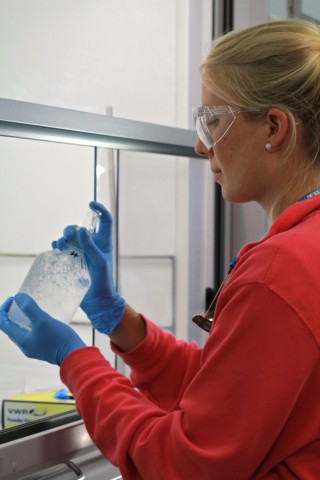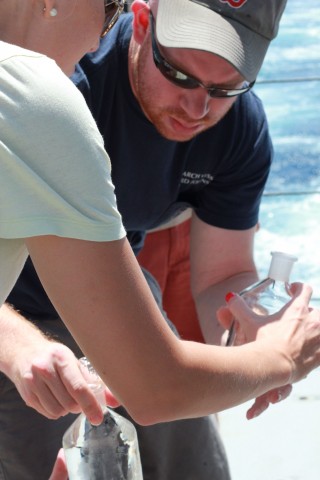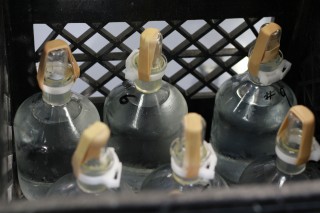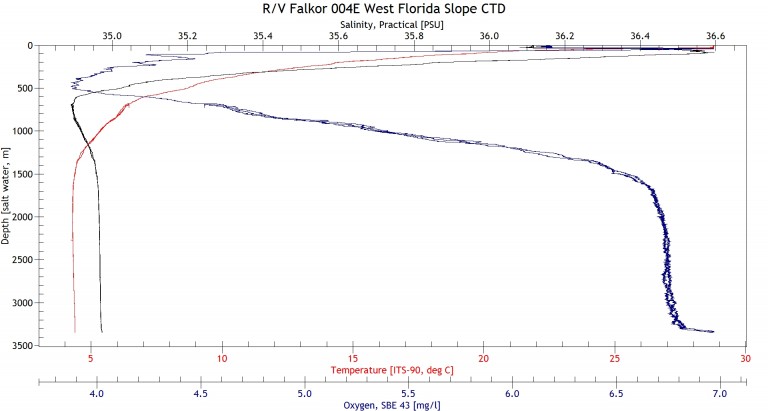
This morning, R/V Falkor stopped at a deep-water site on the way to the first dive site, Okeanos Ridge, in order to deploy a CTD-rosette. CTD stands for conductivity-temperature-depth sensor.
The instrument derives salinity from conductivity, depth from pressure, and temperature from an electrical thermometer. The ‘rosette’ configuration has 24 bottles associated with it, called Niskin bottles. The bottles are triggered by electrical signal to close at specified depths, capturing 12 liter water samples from discrete depths in the water column.
Jay Lunden, a 5th year PhD student at Temple University, is measuring carbonate chemistry in the water collected by the Niskin bottles on the CTD, as well as water collected by 7 bottles on the ROV. Ocean acidification is the main driver for this research. Global warming is one of the consequences of high CO2, but another consequence is ocean acidification. He says, “The oceans are taking up approximately 30% of atmospheric CO2, and, as it dissolves in seawater, it reduces the pH. This has a number of implications for a number of animals, but notably those that form skeletons and shells from calcium carbonate, like corals.”

To quantify ocean acidification, the “basic first step” is to measure the pH and ‘aragonite saturation state’ of seawater. The saturation state measures the potential for aragonite (a common form of calcium carbonate) to dissolve, and this is an important indicator of how well a coral can calcify and form a skeleton. At a value of 1, seawater is saturated with aragonite. At values greater than 1, seawater is supersaturated, so it is easy to form a skeleton; and less than 1, seawater is under saturated, so it is harder to form a skeleton. As oceans become more acidic, the saturation horizon (the depth at which saturation equals 1) becomes shallower, and some deep-water coral communities may become exposed to these more corrosive waters.
Water chemistry in the deep-sea is not as well understood as the chemistry in shallow waters and, according to Jay, the Gulf of Mexico is almost entirely absent from global maps of carbonate chemistry. College of Charleston Master’s student Leslie Wickes is assisting Jay in his measurements. She added, “deep water corals are naturally exposed to a lower pH than shallow water corals, so in fact it is perhaps more interesting to look at deeper waters. There are two ways to look at this: these animals may actually be better adapted to lower pH waters, or they may be the first affected by acidification.”

Jay accompanied his advisor, Dr. Erik Cordes, on a research expedition to the Gulf of Mexico two years ago to determine aragonite saturation states, and he then used this to inform experiments on live animals in the laboratory. This cruise will visit new sites that will enable new comparisons. The current site where we are collecting water off the coast of Florida is particularly interesting because of the Loop Current, which may bring more oxygenated water with less CO2, and therefore potentially more corals.
Today’s CTD cast descended to 3000 meters depth over the course of about 3 hours and it collected water from 16 different depth intervals. Temperature dropped steadily as expected from 29 C at the surface to a minimum of 4 C at 1400 meters depth, where it held steady down to our maximum depth. Salinity was 36 at the surface, climbing to 36.6 at 150 meters depth, indicating a different water mass or water layer. Below this layer, salinity dropped again. Oxygen dropped from nearly 100% at the surface to a minimum of 42% at 500 m depth, then climbed again. This shows an ‘oxygen minimum zone’ at 500 meters depth, the result of microbial activity in the deep-sea.
This CTD cast and water collection is a milestone for the expedition. Yesterday, the research team and crew tested the multibeam system; today they tested the CTD rosette and Niskin bottles; and tomorrow they will test the Global Explorer MK3 remotely operated vehicle in waters 600 m deep, looking for corals at a site that has never been explored before.


